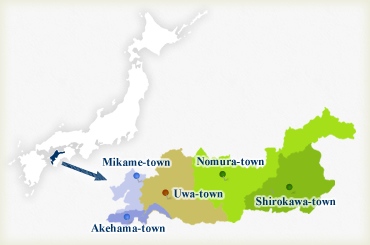Coastal Area (Mikame-town, Akehama-town)
Facing the Uwa Sea, Seiyo City’s coastal area is one of Japans most prominent areas of mikan (oranges) production. With the sun shining down upon the terraced fields and the breeze rolling in from the sea, the local climate allows uniquely delicious mikan to grow. Furthermore, adults and children alike can enjoy a range of activities along the beautiful coastline. During the summer the area bustles with people bathing in the water, indulging in sea-kayaking and camping, or relaxing in one of Seiyo’s hot saltwater baths, brimming with sea minerals.
